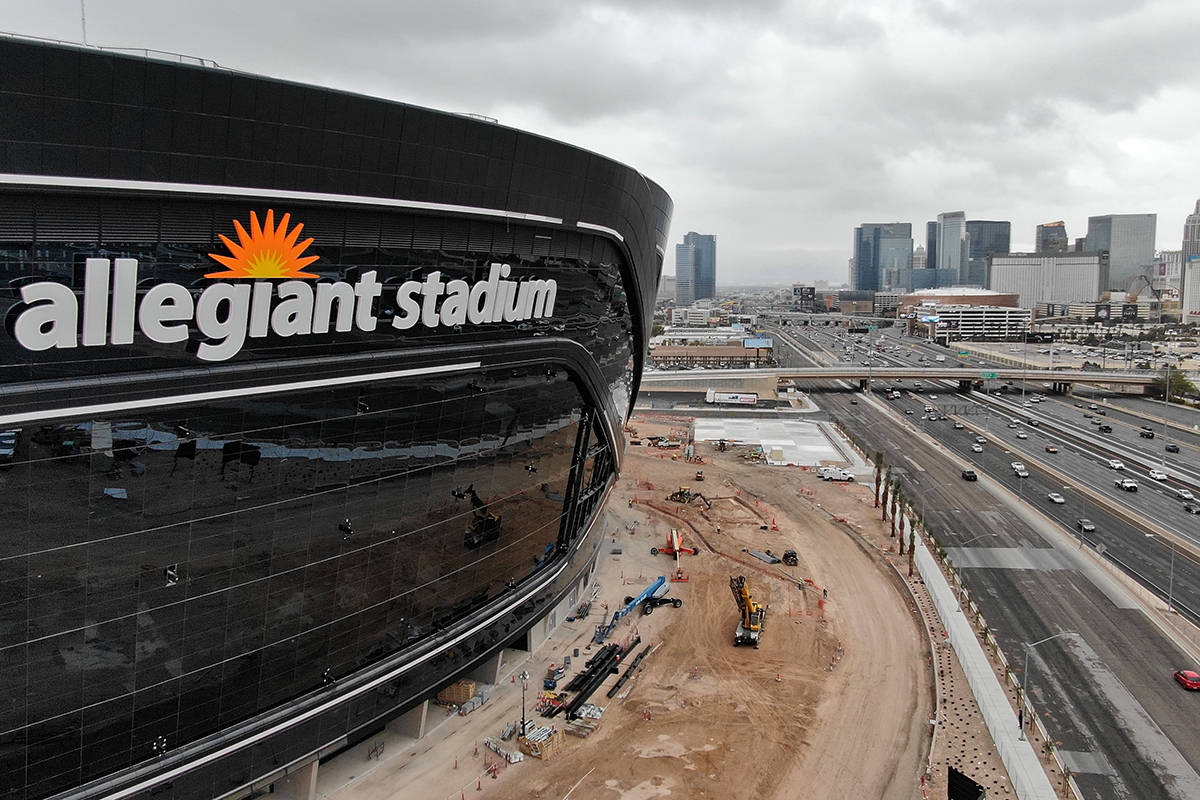
When a rush of 65,000 fans fills Allegiant Stadium for Raiders and UNLV football games and other large events, they’ll find some roads around the $2 billion facility will be closed to vehicle traffic.
The Clark County Commission unanimously approved the Raiders’ transportation plan at Tuesday’s board meeting. The plan calls for the Raiders teaming up with the Metropolitan Police Department to partially close portions of multiple streets in the stadium’s vicinity.
Plans are to temporarily and partially close off some portions of Polaris and Reno avenues, Dean Martin Drive, Ali Baba Lane and Procyon Street in anticipation of increased pedestrian traffic as fans make their way from off site lots to the stadium, said Don Webb, chief operating officer of the Raiders construction subsidiary.
Metro police will direct traffic at 11 points in those areas, with traffic being relegated to one-way only on many of the streets. Plans call for traffic restrictions to be in place five hours before an event and about one hour following.
Polaris will serve as the main feeder for vehicles that are allowed to park on site, or for shuttle buses or limos dropping off passengers.
A separate ride-hailing lot will be operated in a parking lot across the street from the former Frias Transportation building that the Raiders purchased last year to add additional parking within walking distance of the stadium.
Allegiant Stadium has about 2,700 on site parking spaces, with up to 25,000 spaces located off the premises, meaning the bulk of the stadium crowds will be parking off site. Some lots are within walking distance, while others require attendees to be shuttled to the stadium.
“The event day experience isn’t just what happens once you’re inside the building,” Webb said. “It really involves the whole experience going to the stadium and getting back home again.”
Keeping people safe
Setting up the transportation plan has been a work in progress over the last three years, involving multiple agencies and the Raiders, Webb said. The focus was on three main ideas: maximizing public safety, minimizing traffic congestion and maintaining local business activity.
“Keeping people safe, especially the thousands of pedestrians coming to the stadium,” Webb said. “Cutting down on congestion, especially from the automobiles that especially otherwise would flood the surrounding streets near the stadium. And maintaining local business access. We’re part of the community. We’re a big neighbor, but we also want to be a good neighbor.”
Webb said the Raiders have been in contact with around 80 businesses in the area to ensure they’ll have access to their buildings on game days.
Additionally, Webb noted the Hacienda Avenue bridge is still a major part of the stadium’s transportation plan, as an estimated 25,000-30,000 pedestrians are expected to use it to navigate between the Las Vegas Strip and the stadium.
“That’s nearly half the crowd,” Webb said. “That greatly reduces demand on parking, transportation and other actions that would normally be in-and-around the stadium.”
The Raiders plan to spend up to $1.2 million to enhance the surface of the road and the lighting of the bridge. Raiders staff are slated to be stationed along the bridge and Metro officers are expected to be on the bridge as well as a safety precaution.
The transportation plan will be re-evaluated after each event during the first year so it can be adjusted for any issues that arise.
Commissioner Michael Naft asked for the plan to be approved contingent upon stadium representatives coming back to the board in October to go over how the plan has evolved and to address any issues that concern the county or its partners.
Fans in question
Although the Raiders are preparing to host fans at their games at the stadium, it’s still up in the air if that will be allowed when the first events take place in August.
MGM Resorts had been looking to capitalize on pedestrian traffic by offering a tailgate-like experience near the company’s Mandalay Bay and Luxor properties.
However, in an earnings call in late April, MGM Resorts CEO Bill Hornbuckle said the company had paused those plans because it expects there may be some games played in Las Vegas this year without fans.
“We were creating a large pregame environment outside of Mandalay (Bay) and Luxor, which would be pretty special,” Hornbuckle said. “You’d walk over the (Hacienda Avenue) bridge to go to the game and come back (to the) tailgate party. We put that on hold because it’s our general view that if we’re fortunate enough to see real fans, it won’t be 65,000.”
Although there are still uncertainties surrounding when large events will be allowed due to COVID-19 concerns, plans are still on for the first major event scheduled for the stadium — the Aug. 22 Garth Brooks concert.
“100 percent, YES,” Aura Guadagno, spokeswoman for Brooks’ publicist Varnell Enterprises Inc., said in an email Tuesday. “We intend to be there!”
Contact Mick Akers at makers@reviewjournal.com or 702-387-2920. Follow @mickakers on Twitter.
"plan" - Google News
June 17, 2020 at 07:53AM
https://ift.tt/2Y8qqVC
Allegiant Stadium transportation plan OK’d by Clark County officials - Las Vegas Review-Journal
"plan" - Google News
https://ift.tt/2un5VYV
Shoes Man Tutorial
Pos News Update
Meme Update
Korean Entertainment News
Japan News Update
Bagikan Berita Ini














0 Response to "Allegiant Stadium transportation plan OK’d by Clark County officials - Las Vegas Review-Journal"
Post a Comment